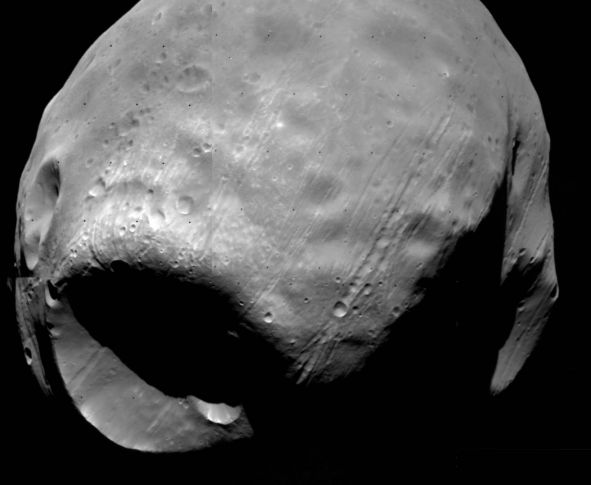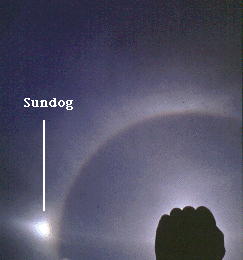Astronomy Picture of the Day
Discover the cosmos! Each day a different image or photograph of our fascinating universe is featured, along with a brief explanation written by a professional astronomer.
Posted on 11/29/2003 2:38:27 AM PST by petuniasevan
Discover the cosmos! Each day a different image or photograph of our fascinating universe is featured, along with a brief explanation written by a professional astronomer.
Explanation: Hurtling through space a mere 3,000 miles above the Martian surface, the diminutive moon Phobos (below and left of center) was imaged against the backdrop of a large shield volcano by the Viking 2 Orbiter in 1977. This dramatic picture looks down from the Orbiter's viewpoint about 8,000 miles above the volcano, Ascraeus Mons. Phobos itself is 5,000 miles below the Orbiter. North is toward the top with the Sun illuminating the scene from the South (black dots are reference marks). For scale, Ascraeus Mons is about 200 miles across at its base while asteroid sized Phobos is about 15 miles in diameter. In this spectacular moon-planet image, volcanic calderas (craters) are visible at the summit of Ascraeus Mons -- while impact craters on the sunlit side of Phobos' surface can also be seen!


The martian radiation environment experiment on NASA's 2001 Mars Odyssey orbiter has collected data continuously from the start of the Odyssey mapping mission in March 2002 until late last month. The instrument has successfully monitored space radiation to evaluate the risks to future Mars-bound astronauts. Its measurements are the first of their kind to be obtained during an interplanetary cruise and in orbit around another planet.
On Oct. 28, 2003, during a period of intense solar activity, the instrument stopped working properly. Controllers' efforts to restore the instrument to normal operations have not been successful. These efforts will continue for the next several weeks or months.
The martian radiation environment experiment detects energetic charged particles, including galactic cosmic rays and particles emitted by the Sun in coronal mass ejections. The dose equivalent from galactic cosmic rays as measured by the instrument agrees well with predictions based on modeling. Validation of radiation models is a crucial step in predicting radiation-related health risks for crews of future missions.
"Even if the instrument provides no additional data in the future, it has been a great success at characterizing the radiation environment that a crewed mission to Mars would need to anticipate," said Dr. Jeffrey Plaut, project scientist for Mars Odyssey at NASA's Jet Propulsion Laboratory, Pasadena, Calif.
JPL manages the Mars Odyssey and Global Surveyor missions for NASA's Office of Space Science, Washington, D.C. Investigators at Arizona State University, Tempe; University of Arizona, Tucson; NASA's Johnson Space Center, Houston; the Russian Aviation and Space Agency, Moscow; and Los Alamos National Laboratory, Los Alamos, N.M., built and operate Odyssey science instruments.


Below are moon dogs (see them?), also called paraselene

May I direct interested parties to a great resource with thorough, easy-to-understand explanations, charts, images, and diagrams:
Disclaimer: Opinions posted on Free Republic are those of the individual posters and do not necessarily represent the opinion of Free Republic or its management. All materials posted herein are protected by copyright law and the exemption for fair use of copyrighted works.